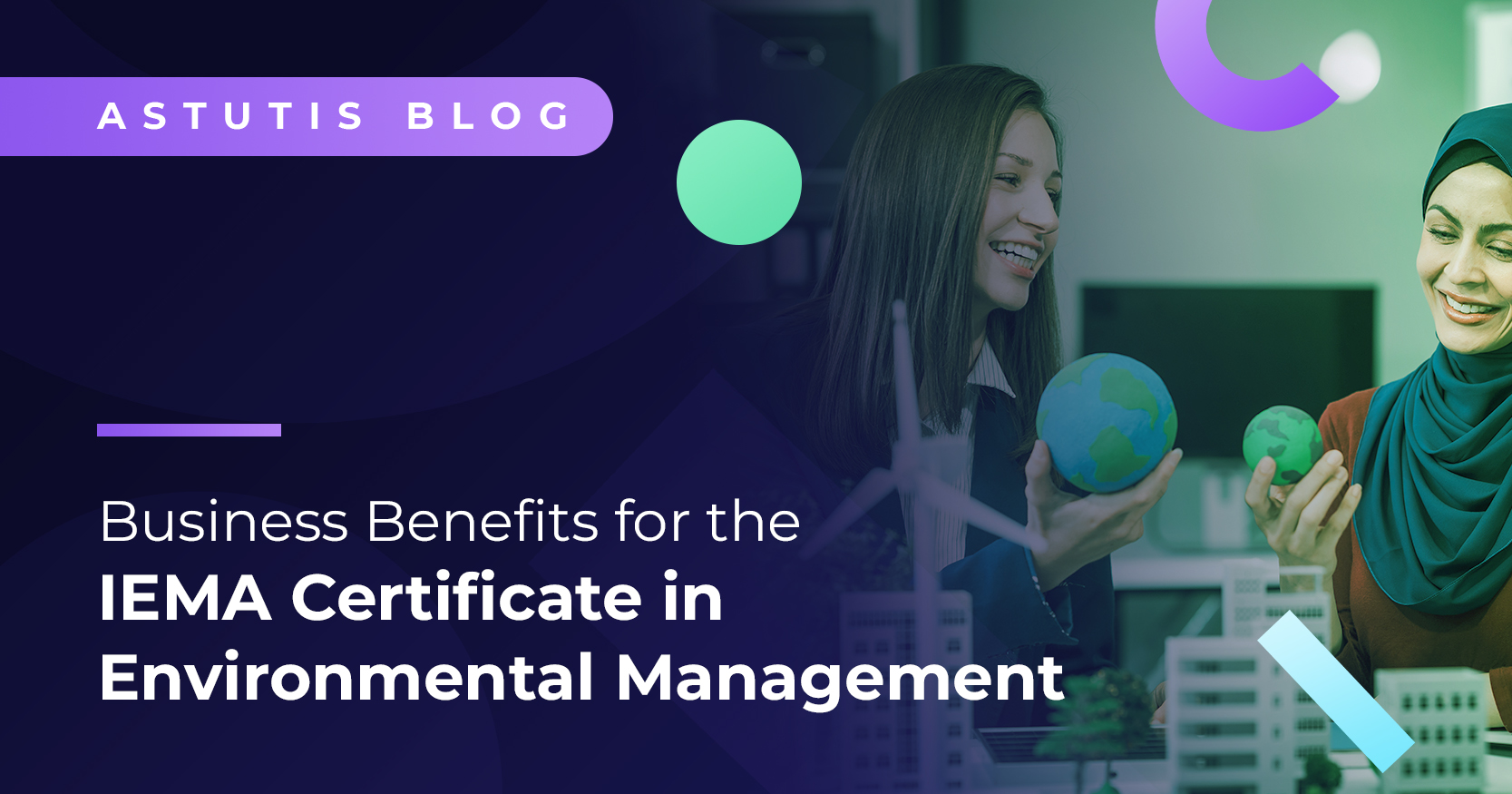IEMA Foundation Certificate in Environmental Management: Learner Diaries #1
For the past several months, I have been studying for the IEMA Foundational Certificate in Environmental Management. The course is considered the perfect entry point into environmental health and safety. My ambition was to further my understanding of environmental issues and in the lead-up to the very important COP27.
I began the Online IEMA Foundation Certificate in Environmental Management in the middle of 2022 and successfully passed with a pass mark of 77% upon the eventual conclusion of the course.
This is how I did it.
Background
The IEMA Foundation Certificate in Environmental Management is widely considered the ideal building block to forge a career around the environment because it has no entry requirements. As the course title suggests, it is a foundation course, and it provides a thorough yet streamlined introduction to the factors that contribute to the planet's environmental state. We encourage learners who have subsequently passed the Foundation Certificate to expand on their learning through the IEMA Certificate in Environmental Management.
IEMA recommends that learners take approximately forty hours (or five days) to learn the materials and revise for the online exam. This three-part blog series will analyse my studying and revision structure and methods, serving as a template for future course learners.
In this inaugural instalment, we will investigate the first ten hours of the course materials and how I strategised my time to retain the knowledge before my exam. It will examine my devised study plan and how I used the broader materials to maximise my success.
Study Plan
Before I dove into the course materials, I established a study plan. This was essential to ensure I stayed on task and had foresight on the individual elements and the course at large. Every Friday, I dedicated 3/4 hours to the course. After ten weeks, I had gone through all the course materials, passed the learning checks and succeeded on several mock exams.
The course is structured as follows;
- Element One: Core Environmental Principles - 5 hours
- Element Two: Sustainability and Mega-Trends - 5 hours
- Element Three: Policy and Legislation - 5 hours
- Element Four: Environmental Management Systems - 5 hours
- Element Five: Performance Evaluation - 5 hours
- Element Six: Additional Management and Assessment Tools - 5 hours
- Element Seven: Communication and Management of Change - 5 hours
I spent roughly, approximately five hours on each element. I began by reading through all the materials for each element at least twice. Re-reading text repeatedly is a way for me to retain the information. This is not for everyone, but I recommend re-reading the information or writing down some important information. Understanding what is important to remember can be difficult. I approached this by going through the learning checks and deciphering the critical information. The Astutis Learning Checks are designed to ensure that if you pass the Learning Checks, you are ready to move on to the next element. If a learner fails the Learning Check, Astutis advises that the learner is not ready to move on to the next element.
At the time of writing this blog, the IEMA Foundational Certificate in Environmental Management course is available to study online in two ways. Learners can go through the more traditional method of course materials or study through Astutis WorkSmart. To maximise my understanding, I completed both. This first instalment will cover the first ten hours of course material study if learners go through each element in order.
Element One: Core Environmental Principles
Element One was a welcome introduction to environmental management. It begins by showcasing the main natural cycles, notably the carbon, nitrogen, water and phosphorus cycles. WorkSmart covered this by encouraging me to expand upon my understanding. It directed me to several additional readings and videos. For this reason, some learners who prefer a more visual learning method may prefer the WorkSmart part of the course.
Having been directed back to the course, I moved on to the next stage of the element, ecosystem services. I quickly understood that ecosystem services are the effects of the environment. There are four different ecosystem services;
- Provisioning Services
- Regulating Services
- Cultural Services
- Supporting Services
I particularly admired studying the WorkSmart feature at this early point in the course. It featured minimal text and focused on visual cues, which helped depict each service clearly and in a visually appealing manner. After writing down each service and what made each unique, the course suggested I move on to the types of ecological interactions. At this stage, many pointers to videos help illustrate the primary differences, which helped add separation to each.
Then came the latter part of the element, which I found highly intriguing, the effects of human intervention on natural cycles and ecological systems. At this point, this was the first sequence that touched on climate change. Climate change was one of the more significant areas of interest for me coming into the course, and Element One lightly touches on it. During this stage, more text is introduced to cover each effect aptly. More text or not, it was fascinating. I began to feel my eyes widen at humanity's ever-expanding impact on the environment. I was embarrassed that I had such a limited understanding of the different sources of pollution. But I was quickly able to turn that around by mastering the eight sources of pollution. The WorkSmart links to visual media to really assist in reinforcing the precise terminology for each. For instance, did you know that thermal pollution occurs when chemicals are released into the water at a temperature different from the water?
Element Two: Sustainability and Mega-Trends
Element Two introduced me to the latest mega-trends: Globalisation, Population Growth, Urbanisation and Artificial Intelligence. Then, without too much text, the WorkSmart feature describes the implications of these trends. For example, The course points out that with an estimated population of more than 8 billion by 2030, humanity will need 50% more energy, 40% more water and 34% more food.
The next phase of Element Two is focused on sustainable development. Sustainable development is the process humanity must adhere to in order to achieve sustainability. It introduces learners to the five sustainable capitals and investigates each in detail. This leads to an analysis of the core governance principles. The core governance principles are a methodology model that governments and organisations should follow to help spur sustainable development. These consist of;
- Accountability
- Equality
- Inclusivity
- Integrity
- Stewardship
- Transparency
- Cultural context
Element Two was significantly shorter in course material than Element One. I found myself using the remaining time of the five hours allotted to go through the additional readings from both Elements One and Two. The readings help embed broader, contextual knowledge that could play a role in the eventual exam. They gave me a more contextualised understanding of the issues discussed in the elements. Furthermore, they gave me extra assurance by having additional knowledge.
Element Three: Policy and Legislation
Element Three focuses on the political and legislative responses to the environmental situation. It underlines the core principles that underpin environmental policy - these include;
- The Polluter Pays Principle
- The Pre-Cautionary Principle
- The Producer Responsibility Principle
- The Principle of Best Practice
- The Hierarchy Approach
- Life Cycle Thinking
Element Three features the most text of the first three elements. The course incorporated a wider berth of detail because the core principles can be complicated. Please look at the WorkSmart link links if you prefer less text. The videos were welcome drinks break. The WorkSmart feature does incorporate text, but it is significantly less.
Key Environmental Policy Instruments are the next topic the course introduces. These are the fundamental methods governments can use to inspire environmentally friendly behaviour. These consisted of Legal, Fiscal, Market-based and Voluntary instruments. I found the terminology of these policy instruments somewhat convoluting and preferred to repeatedly write each policy with a brief description on paper. I used a colour coding technique to further separate each in my head. To help minimise my uneasy feeling regarding this section, I also repeated the Learning Check for this section several times. However, you must rely on something other than repeating the Learning Checks to clarify success because the questions stay the same. Instead, I recommend mixing up the process with actual mock exams available at request from IEMA.
Next came a background into environmental legislation, initially focusing on civil and criminal courts and the four environmental civil wrongs. I found this fascinating. Coming into the course, I wanted to understand better the repercussions for organisations that fail to hit environmental regulations. The course gave me several in-depth and brief examples of each type of environmental malpractice case, which cemented my knowledge surrounding environmental law and regulation. I found that real-life case studies help to contextualise the information, giving more life to the material I was trying to retain.
Final Overview of Elements 1-3
To conclude, elements 1-3 focus on each concerning party involved in the environmental agenda; earth, governance and human behaviour. They gift an eye-opening entry point into environmental management that wasn't too text-heavy. Plus, the WorkSmart feature gave me a more breakaway experience, pointing to additional reading and visual media that offered me a text alternative. This ensured that the first three elements of the course seemed to fly by, but use this spare time to your advantage. I encourage everyone to make the most of the additional materials at the courses' disposal; the videos helped relay the information in a fresh, quick and short fashion.
The course gave me a gentle introduction to the challenges facing the environment. Elements One and Two offered a lighter studying experience that I could complete ahead of schedule, gifting me more time to widen my understanding with additional materials. Element Three provides the most information of all three elements. It will require some note-taking, and I encourage everyone to dedicate some time to the additional readings in this section because they offer alternative descriptions of complicated principles and policies.
In the next instalment, I will be analysing my attempt to study elements 4-6, which are;
Element Four: Environmental Management Systems
Element Five: Performance Evaluation
Element Six: Additional Management and Assessment Tools
I will be analysing my exam revision during the final instalment of this series of blogs. Instalment three will also feature my advice for the best way to approach the exam, time management and the exam process.
If you are intrigued by the IEMA Foundation Certificate in Environmental Management, check out the course page below.
Related Blog

Real Life Stories










